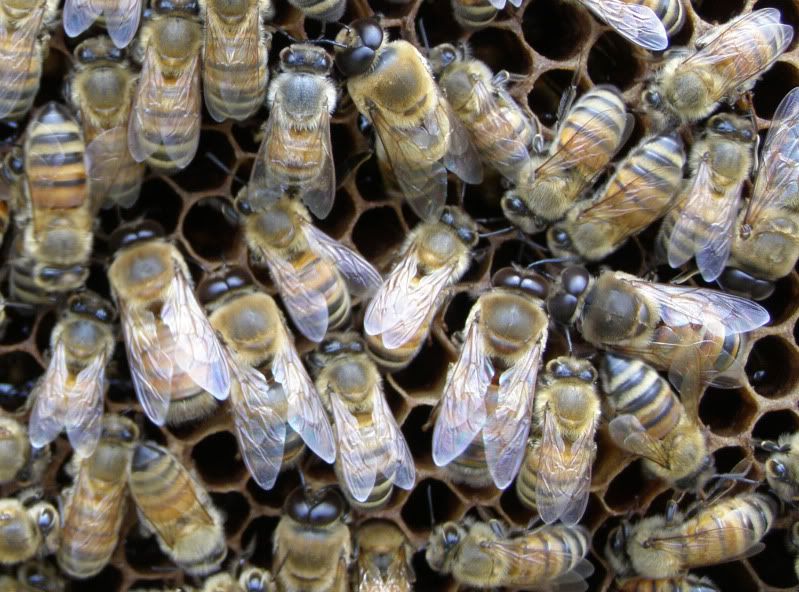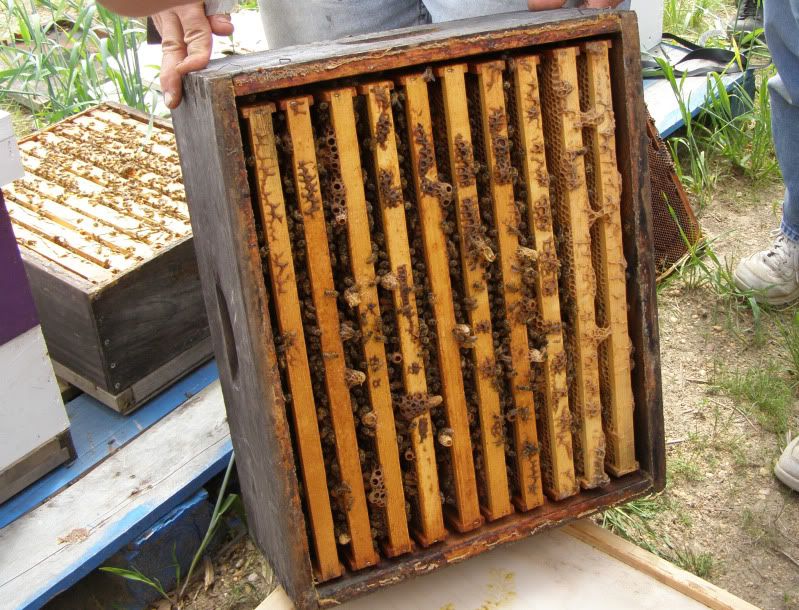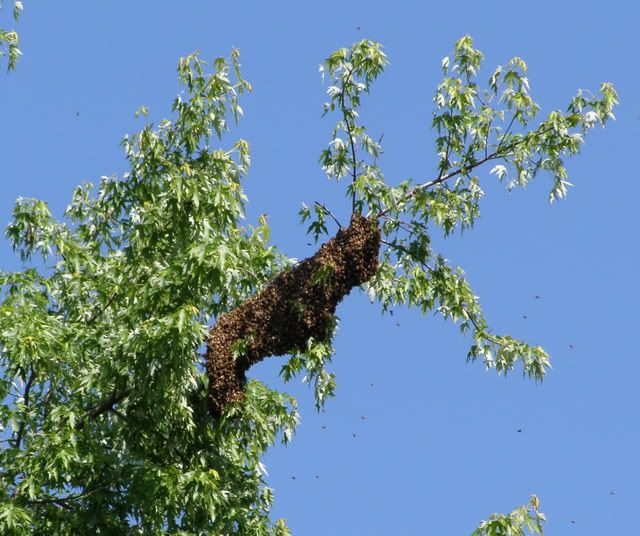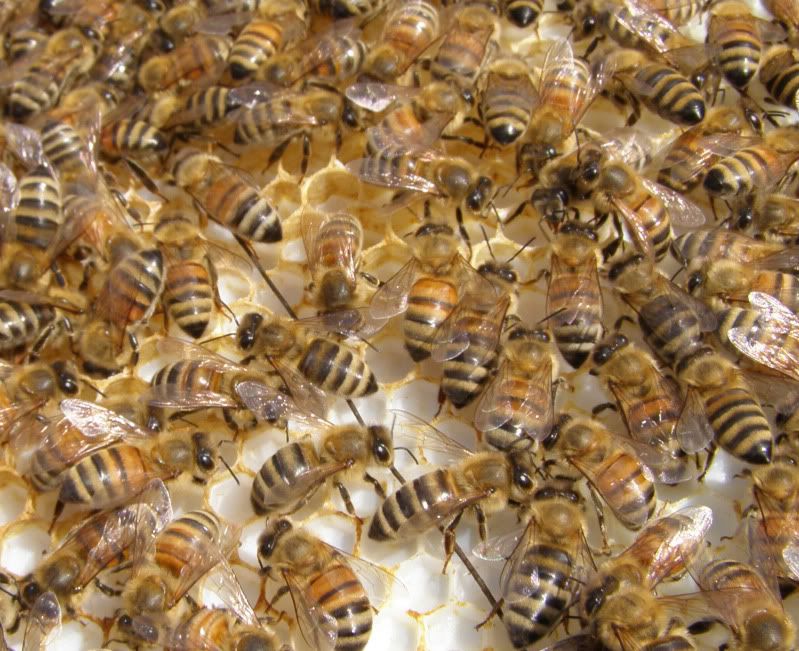
Behold! The queen honey bee. She's the big one in the middle. (Note this is not my finger in the photo.) Unlike ants, bumblebees, wasps, and other Hymenoptera, honeybees prepare for their children's future. They build a nest for them and then the parent queen leaves with some workers to do so again. This usually takes place in the spring and early summer but in souther states this can be a year long event as it is in the tropics. Hives can swarm upwards of 5 times a year, but mostly it's only done once. They otherwise swarm when needed.

Also in the nest are drones, male honey bees, seen here. They're the slightly bigger ones among the workers. Despite their parent hive, drone bees will fly to and from any hive they like. They march right past guard bees and are only removed if the hive is in lack of food. During the winter they're casted out by the thousands to die horribly. For the rest of the year though drones can make up about 1/10th of the hive. They contribute nothing other than ensuring new queens are mated with as they become available. Mating takes place within 5 days of the new queen hatching and is done in the air.

Before swarming the queen of the hive makes sure there are plenty of replacements. Special queen cells are made for her to lay eggs in. These are usually under the frames in the standard beehive used today. They can actually occur anywhere on the frame but off to the sides or under them are the most common. (There is also the issue of supersedure that I'm not going to get into.) Weather allowing, the old queen should be up and out of the hive with roughly 60% of the bees before any of those queen cells open. Otherwise, the old queen will remain in the hive and leave at the next convenience. When it comes to queens, mothers and daughters get alone great. It's sisters that do battle.

Swarming happens in the morning or close to noon. Often the bees don't know where they're going yet so they land on a tree or shrub nearby. Some of you might be seeing a lot of these around this time of year. Should a swarm of bees land in your yard, don't panic! Contact your county office or the police, and tell them you have a swarm of bees and you'd like someone to come take care of it. There's usually a good group of people who do beekeeping as a hobby/small business around. Note that they will only collect swarms of honey bees, they're not exterminators, so don't call them for wasps, or hornets, it's annoying.
Some people do this for free, though it is customary to pay for gas. Others "charge" money for this service. Let me make this clear. If you're in the norther US or any area that experiences winter, then the bees can only establish if they are inside of a structure. The hollow part of a dead tree is ideal. Down south where it stays fairly warm all year even in the winter is the ONLY time when you have hives make their nests out in the open. That means if you're in an area that experiences cold winters a hanging swarm on a tree, bush, or the side of your house, etc... is very likely going to fly somewhere else within 24 hours. However, if they've moved into the walls to your house, shed, or any standing structure it's well worth it to pay now to get them out of there. Read on to learn why.

Swarms are amazing. When it comes to nest building they can fill out a box of 10 frames in less than a month. In the photo above you can see under the bees they've started to draw out the comb, and build cells. To put this in perspective that's like building a 12 inch wide hive 10 feet long. Imagen that in the walls to your home, and that's just the first month. Nest building does slow down after that but that doesn't change the fact that they're in your walls. Hives inside of our homes are real fire hazards. The melting wax over the summer can drip down and get all over electrical work. Worst of all, a weak hive of bees or one that dies off get all manner of pest feeding on the wax, and honey. Wax moths, roaches, ants, assorted beetles will be drawn to the walls of your home. Yes they are clearing out the nest for you but they're also inside your home. For the most part though they're not doing anything bad but the threat of electrical fire should be taken seriously.
It is the roll of the beekeeper to prevent swarms. Mostly by managing splits and combining weak hives together as needed. This will maximize honey yields. But the beekeeper can't do everything they want to. Weather conditions may prevent them from opening their hives, and other things such as a busy day job can also get in the way. Local beekeepers shouldn't be blamed totally though for swarms of bees. There are plenty of feral hives (wild) around nesting in places. Abandoned homes and hollow trees are idea places for them to nest.
A few odd things about Swarms
1) They don't always have a queen. Problems occur and the queen might have had something go wrong. A damaged wing, or reluctance to leave the hive among other reasons can cause the workers to leave without her. So swarms of bees occasionally try to start a new nest without a reproductive. Oops.
2) Swarms can sometimes have two or more queens. In hives with massive population issues often leave the newly emerging queens with to many sisters to kill. Sure a young queen is supposed to hatch out and take control over the hive. But hives that have over population will have made to many queen cells and often several young queens hatch out with the same idea. Swarm again. Sometimes their mother will not have swarmed out yet. This means multiple queens can be in a swarm and in a new hive for a year or so. It's more common than you think. Queens that are sisters will fight to the death eventually. But that doesn't stop the fact that the mother and daughter queen are still laying eggs in the same hive. Both will swarm next spring if not sooner.